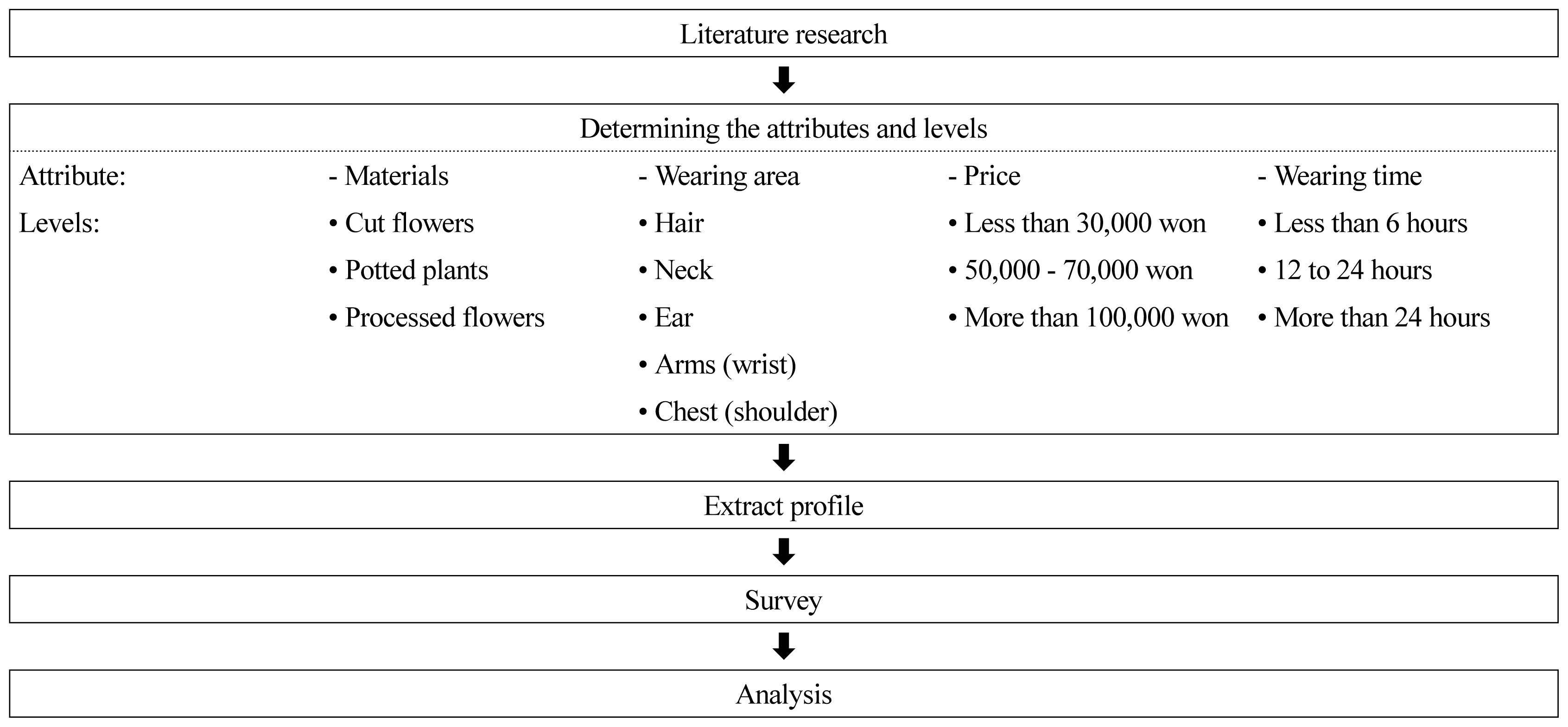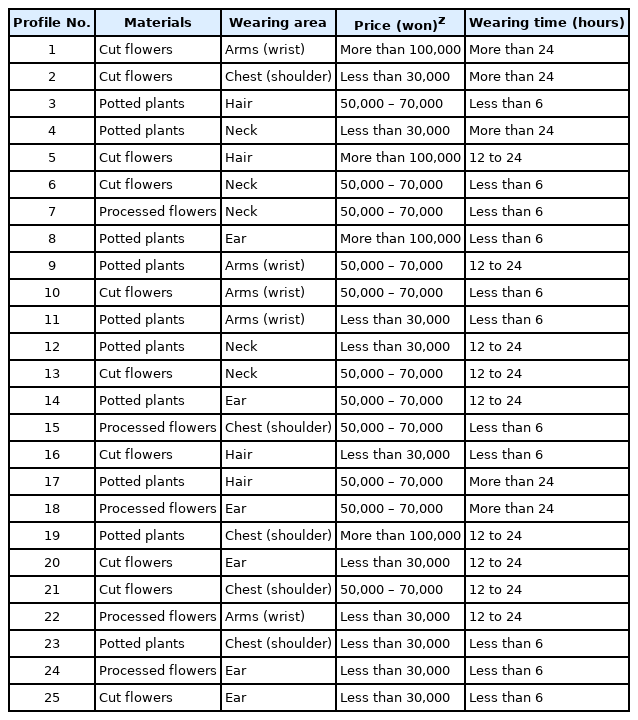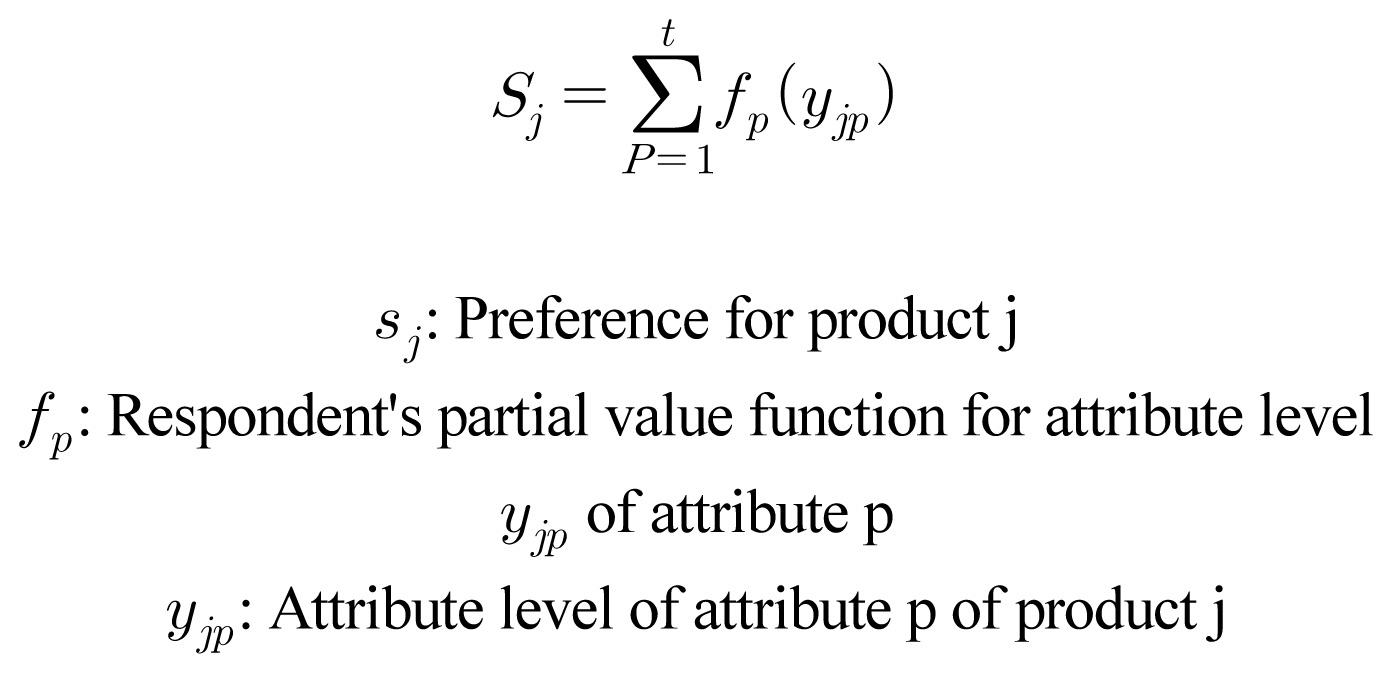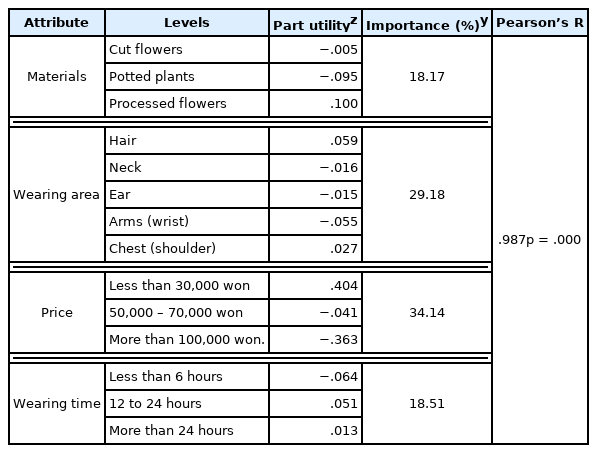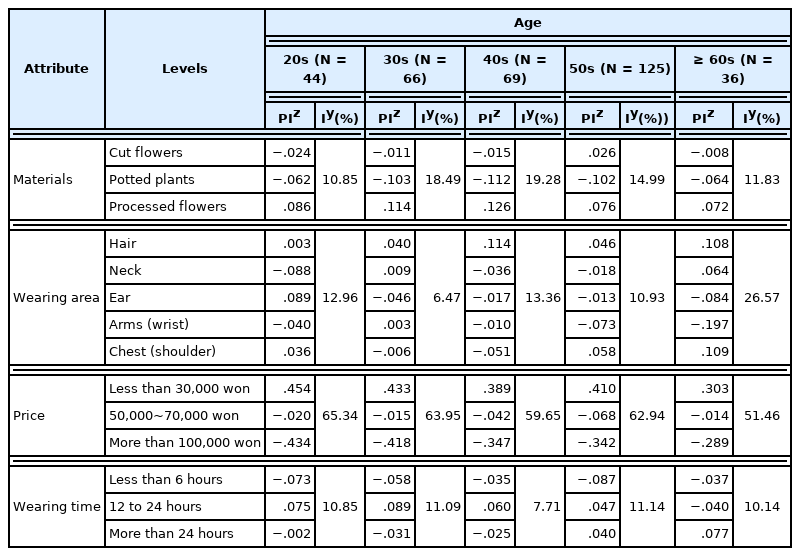Preference Analysis for Flower Jewelry Using Conjoint Analysis
Article information
Abstract
Background and objective
This study was conducted to determine the preferences in flower jewelry by conducting a survey using conjoint analysis on the perception of flower jewelry and provide basic data for development of flower jewelry products.
Methods
For the conjoint analysis, four attributes of flower jewelry were selected. Attribute 1 was related to the main material of flower jewelry, presented in three levels: cut flowers, potted flowers, and processed flowers. Attribute 2 was related to wearing area presented in five levels of wearing area: hair, neck, ear, arm (wrist) and chest (shoulder). Attribute 3 was related to price provided for selling products in flower shops, presented in three levels: less than 30,000 won, 50,000–70,000 won, and more than 100,000 won. Attribute 4 was related to flower jewelry wearing time, presented in three levels: less than 6 hours, 12–24 hours, and more than 24 hours. After extracting 25 profiles through orthogonal design, a questionnaire survey was conducted on 402 general participants, from which the responses of 343 participants were analyzed.
Results
By attribute of flower jewelry, the respondents attached most importance to price (34.14%), followed by wearing area (29.18%), wearing time (18.51%), and material (18.17%), proving that the general public attached most importance to price (Pearson’s R = .987, p = .000). The preference in levels by attribute was highest for processed flowers in material, less than 30,000 won in price, hair in wearing area, and 12–24 hours in wearing time.
Conclusion
By making flower jewelry based on the results of the analysis, it would be possible to help increase items sold in flower shops as well as their income.
Introduction
There has been an unprecedented global crisis since the outbreak of COVID-19. COVID-19 has brought rapid changes to all areas of our daily lives from culture and hobbies to even religion, making workers work from home and students take classes online. Many outdoor activities such as weddings, graduations, and entrance ceremonies were cancelled due to COVID-19, which reduced the consumption of flowers and brought difficulties to flower shops and farms (Yunhap News, 2021). Moreover, consumption of floriculture products sold in flower shops tended to be focused on specific celebrations such as Parents’ Day or graduation and entrance ceremonies, while the culture of consuming flowers in daily life was not well created (Seol et al., 2020).
Decorating bodies using cut flowers is referred to as body flowers, which are mostly decorated on hair, shoulders, chest, and wrists or any other parts of the body depending on the purpose (Song and Park, 2019). Some view flower jewelry as a part of body decorations, but the floral design job descriptions distinguish body flowers from flower jewelry (Meisternet, 2019a), indicating that there is a difference between the two. In floral design, flower jewelry uses plant materials and non-plant materials, unlike flower-themed decorations in jewelry design. It is a casual flower decoration designed to be used for short events and is easily detachable in a relatively small size, decorating hair, neck, ears, arms, wrists, shoulders, and chest (Kim et al., 2020). Kim et al. (2020) analyzed the trend in flower jewelry among works presented for 108 months in specialized monthly magazines where professional floral design artists display their works. As a result, there were total 96 works of flower jewelry, proving insignificant preference of floral designers, and necklaces accounted for 57.29% of all flower jewelry works, indicating that flower jewelry tends to be focused on necklaces instead of decorating various parts of the body.
Floral design product planning is carried out in the order of discovering demand through environmental analysis, selecting products for development, and creating a new product concept after customer needs analysis (Ministry of Education, 2018b). Customer needs analysis is necessary to develop products using flower jewelry in floral design.
This study was conducted to identify the preference for flower jewelry by surveying the perception of flower jewelry using conjoint analysis and to provide basic data for development of flower jewelry products.
Research Methods
Questionnaire design
A survey was conducted using conjoint analysis. Conjoint analysis is a typical method of analyzing consumer utility in marketing and is an analytical technique that predicts the product that will be chosen by customers by estimating the utility that customers give to the attributes of the product. Conjoint analysis was developed in mathematical psychology and is a generic term for methods to mathematically analyze consumer preferences for multi-attribute stimuli constructed through experimental design (Ha, 2012).
The process of conjoint analysis is as follows (Fig. 1). Literatures on conjoint analysis were first examined, after which the attributes and levels were selected. Attribute 1 is related to the main materials of flower jewelry, presented in 3 levels such as cut flowers, potted flowers, and processed flowers used as the main materials for floral design (Ministry of Education, 2018a). Attribute 2 is related to wearing area (where flowers are worn) presented in the study of flower jewelry design trends and expressive technique analysis (Kim et al., 2020), presented in 5 levels such as hair, neck, ear, arm (wrist), and chest (shoulder). Attribute 3 is related to the consumer preference survey to sell products at flower shops, thereby presenting product price in 3 levels such as less than 30,000 won, 50,000–70,000 won, and more than 100,000 won. Attribute 4 is related to flower jewelry wearing time (how long flowers are worn), presented in 3 levels such as less than 6 hours, 12–24 hours, and more than 24 hours based on the 6 hours presented for cut flower longevity in flower jewelry at the 2018 Floral Design Regional Skills Competition (Meisternet, 2018) and the 24 hours presented for cut flower longevity in flower jewelry at the 2019 Floral Design Regional Skills Competition (Meisternet, 2019b).
Profile extraction and conjoint analysis
There were total 135 (3 × 5 × 3 × 3) cases of profiles that could be presented according to the key attributes of the survey such as materials, wearing area, price, and wearing time as well as levels according to attributes, but having the respondents assess the preference of all these profiles is too much of a burden for them, which is not feasible. Therefore, 25 profiles were extracted using orthogonal design of IBM SPSS v.19.0 program to adequately reduce the total number of stimuli (Table 1).
The partial value function model was applied to estimate the value of the survey. The partial value function model is a model that measures the utility assuming that each attribute level of flower jewelry has individual partial value (Ha, 2012). This was applied to this study since it could be assumed that each attribute level of flower jewelry individually has partial value (Fig. 2).
Survey and analysis
The survey on the preference in flower jewelry through conjoint analysis was conducted on social networking services (SNS) from October 20 to December 15, 2020. We presented 25 profiles along with pictures of flower jewelry and had the participants rate them on a 5-point scale (5 points for most preferred, 4 points for preferred, 3 points for neutral, 2 points for not preferred, and 1 point for least preferred). Out of 402 participants, 343 participants were used in the analysis excluding 59 who provided unclear or insincere responses. The analysis was conducted after statistical treatment according to the partial value function model using IBM SPSS v.19.0 program. Normality was confirmed by Pearson’s correlation coefficient.
Results and Discussion
Demographic distribution
The demographic distribution of the respondents show that there were 89 male (25.9%) and 254 female respondents (74.1%), indicating that there were more women. It seemed that men showed a low response rate due to lack of interest in flower jewelry, whereas women showed a high response rate due to their greater interest in flower jewelry. By age, 128 respondents were in their 50s (37.4%), 69 were in their 40s (20.1%), 66 were in their 30s (19.2%), 44 were in their 20s (12.8%), and 36 were in their 60s (10.4%). By education level, 149 respondents had a bachelor’s degree (43.4%), 74 had a master’s degree (21.6%), 65 had an associate degree (19.0%), 29 had other education levels (8.4%), and 26 had a doctoral degree (97.6%). Those who responded ‘other’ included high school graduates and university freshmen. As for qualifications, most of the respondents said they had no certificate (240 respondents, 70.0%). There were 40 respondents with a private qualification certificate in flower design (11.7%), followed by 35 with both national and private qualification certificates in flower design (10.2%), 21 with national technical qualification certificate Craftsman Floral Design (6.1%), and 7 with national technical qualification certificate Industrial Engineer Floral Design (2.0%) (Table 2).
Preferences in flower jewelry by attribute
Preferences in flower jewelry by attribute are as follows. The highest preference was for price (34.14%), followed by wearing area (29.18%), wearing time (18.51%), and material (18.17%), proving that the general public attached most importance to price (Pearson’s R = .987, p = .000, Table 3). Wearing time and material did not show much difference in the importance of preference. The preference in levels by attribute was highest for less than 30,000 won (part utility .404) in terms of price, followed by 50,000–70,000 won (part utility −.041) and more than 100,000 won (part utility −.363), showing that there was a higher preference for lower price. In terms of wearing area, hair showed the highest preference (part utility .059), followed by chest (shoulder, part utility .027), ear (part utility −.015), neck (part utility −.016), and arm (wrist, part utility −.055), proving that there was a high preference for decorating hair with flower jewelry. However, the study by Kim et al. (2020) that analyzed the flower jewelry design trends and expressive techniques revealed that necklace was the most common flower design piece, which was different from the results of this study. This difference may be due to the fact that works included in specialized floral design magazines in the aforementioned study were created by floral design experts, which showed different preferences in wearing area compared to the preference survey on the general public conducted in this study. The level preference in wearing time was highest for 12–24 hours (part utility .051), followed by more than 24 hours (part utility .013) and less than 6 hours (part utility −.064), showing that the respondents wanted to wear flowers for about 12–24 hours. By material, the highest preference was for processed flowers (part utility .100), followed by cut flowers (part utility −.005) and potted flowers (part utility −.095), proving that they preferred to use processed flowers as the material.
Preferences in flower jewelry by attribute according to age
As a result of surveying the preference in flower jewelry among the general public, the importance according to age is as shown in Table 4. All age groups responded that price was most important. There was a difference in what they preferred second-most: the 30s (18.49%), 40s (19.28%), and 50s (14.99%) preferred materials, while the 20s (12.96%) and 60s or above (26.57%) considered wearing area the second-most important. As for importance by level of materials used, all age groups preferred processed flowers. For importance by level of wearing area, the 20s attached importance to ear (part utility .089), 30s to hair (part utility, .040), 40s to hair (part utility, .114), 50s to chest (shoulder, part utility, .058), and 60s or above to chest (shoulder, part utility, .109), proving that there is a difference in preferred wearing area among age groups. For importance by level of price, all age groups preferred the price of less than 30,000 won. For wearing time, the 20s–50s preferred 12 hours to 24 hours, whereas 60s or above preferred more than 24 hours (part utility, .077).
Preferences in flower jewelry by attribute according to education level
As for preferences in flower jewelry according to education level, all of those with associate degrees, bachelor’s degrees, master’s degrees, and doctoral degrees responded that price was most important (Table 5). The percentages of preference for price were 56.57% for the associate degree, 63.78% for the bachelor’s degree, 64.62% for the master’s degree, 57.92% for the doctoral degree, and 72.65% for others including university freshmen and high school graduates, but there was a difference according to education level. The attributes considered second-most important were materials for the associate degree (21.21%) and bachelor’s degree (18.80%), wearing time for the master’s degree (11.44%), and wearing area for the doctoral degree (26.82%), showing a difference according to education level. Preference by level of materials was processed flowers for the associate degree (part utility, .132), processed flowers for the bachelor’s degree (part utility, .136), processed flowers for the master’s degree (part utility, .051), and processed flowers for others (part utility, .037), which was different from cut flowers chosen by the doctoral degree (part utility, .043). Preference by level of wearing area was hair for the associate degree (part utility, .065), bachelor’s degree (part utility, .053), and master’s degree (part utility, .070). Hair decorations include hairpins, headbands, hair ties, and tiaras. The doctoral degree (part utility, .170) and others (part utility, .068) preferred to wear flowers on the chest (shoulder). These decorations include corsage for chest and shoulders. As for price, all education levels preferred the price of less than 30,000 won. For wearing time, the associate degree (part utility, .048), bachelor’s degree (part utility, .077), and doctoral degree (part utility, .056) preferred 12–24 hours, and the master’s degree (part utility, .056) and others (part utility, .037) preferred more than 24 hours.
Preferences in flower jewelry by attribute according to qualification certificate
Qualification certificates are classified into national qualification certificates such as Craftsman Floral Design or Industrial Engineer Floral Design and private qualification certificates. As a result of examining the preferences in flower jewelry according to floral design certificate, it was found that price was preferred the most by all respondents with a national qualification certificate, a private qualification certificate, both national and private qualification certificates, and no qualification certificates (Table 6). The attribute considered second-most important was wearing area for those who have a national technical qualification certificate Craftsman Floral Design (24.30%). However, materials were preferred second-most by those who have a national technical qualification certificate Industrial Engineer Floral Design (32.86%), private qualification certificate (17.72%), both national and private qualification certificates (20.15%), and no certificates (14.46%). Preference by level of materials was highest for processed flowers among all qualification certificates. Preference by level of wearing area was neck for Craftsman Floral Design, arm (wrist) for Industrial Engineer Floral Design, and hair for private qualification. Those who have both national and private qualification certificates preferred to decorate their chest (shoulder). Those without a certificate preferred to decorate their hair, proving that there was a difference in the preferences in wearing area depending on qualifications. Preference by level of price was highest for less than 30,000 won among all respondents. As for preference by level of wearing time, all qualifications preferred 12–24 hours.
In summary of the conjoint analysis results, consumers attached most importance to price in flower jewelry, followed by wearing area, wearing time, and materials. More specifically, price was considered most important in the comparison by attribute such as age, education level, and qualification of consumers, especially the price of less than 30,000 won. This is in line with the fact that, despite the recently increasing consumer interest in floriculture products, they generally think that flowers are expensive and perceive them as luxury items (Park and Oh, 2019), considering that ‘high price’ is the reason for their dissatisfaction when purchasing cut flowers (Yoo, 2018). Preference by material according to education level was highest for cut flowers among those with a doctoral degree, while other groups all preferred processed flowers.
A study on the sales of flower shops in Korea focused on flowers with high rate of sales by item proved that dried flowers showed highest sales among professed flowers in both the peak season and throughout the year, followed by preserved flowers, artificial flowers, pressed flowers, and collages (Seol et al., 2020). This suggests that flower jewelry products made with processed flowers could be sold consistently throughout the year. As for preference by level of wearing area, most respondents generally preferred hair decorations. However, chest (shoulder) was preferred among those aged 50–60s or above, those with a doctoral degree and other education levels, and those who have both national and private qualifications. In a survey on the sales of flower shop by item, Seol et al. (2020) reported that corsage sales increase during the peak season in May, ranking 3rd, due to events such as Parents’ Day or Teachers’ Day. This study also implied that respondents aged 50–60s or above preferred to wear flower jewelry on their chest (shoulder) because they have experience wearing corsage in such events. The respondents also preferred processed flowers, which could be worn for more than 12 hours, proving that they could be used to develop new products in flower shops.
Before the COVID-19 pandemic, office workers tended to invest more in themselves with the expansion of the five-day workweek system, which increased the cost of leisure activities per capita, and parties rapidly became a trend as well as a culture (Im, 2011). Various party cultures became common due to the development of culture and arts in the 21st century, which increased accessibility to parties. Floral design was more frequently used to decorate the party venues, and party guests also wore more body decorations (Yeo and Jeong, 2014). Body flower design, which is a relatively similar concept with flower jewelry, also developed from mostly decorating hair and shoulders to more diverse and practical purposes such as rings, glasses, hats, handbags, umbrellas, necklaces, and neckties (Song and Park, 2020). This study also proved the similarities and differences in the preferences by attribute according to age, education level, and qualification certificate of consumers regarding flower jewelry. Thus, developing flower jewelry products will help increase income for flower shops when the party culture is in full swing again once the COVID-19 pandemic ends. Moreover, a multiple-response survey on the types of floriculture products purchased on SNS showed that flower bouquets were purchased the most (36.0%), followed by flower baskets (28.0%), pots of foliage and flowering plants (14.0%), flower boxes (12.0%), wreaths and garlands (6.0%), and wedding bouquets (4.0%) (Seo et al., 2019), suggesting the need to increase the diversity of sales items to increase consumption of flowers in everyday life (Seol et al., 2020). Flower jewelry can serve as a new form of product to make flowers a part of daily life.
Conclusion
This study was conducted to determine the preferences in flower jewelry by conducting a survey using conjoint analysis on the perception of flower jewelry and provide basic data for development of flower jewelry products. Conjoint analysis is a typical method of analyzing consumer utility in marketing. It is applied to various fields such as preference analysis on horticultural activities of teachers in early childhood education (Jeong et al., 2020). Attributes and levels were selected for conjoint analysis. Attribute 1 is related to the main materials of flower jewelry, presented in 3 levels such as cut flowers, potted flowers, and processed flowers used as the main materials for floral design. Attribute 2 is related to wearing area presented in 5 levels such as hair, neck, ear, arm (wrist), and chest (shoulder). Attribute 3 is related to price provided for selling products in flower shops, presented in 3 levels such as less than 30,000 won, 50,000–70,000 won, and more than 100,000 won. Attribute 4 is related to flower jewelry wearing time, presented in 3 levels such as less than 6 hours, 12–24 hours, and more than 24 hours. We randomly extracted 25 profiles through orthogonal design and analyzed 343 respondents that participated in the survey on SNS.
As a result, by attribute of flower jewelry, the respondents attached most importance to price (34.14%), followed by wearing area (29.18%), wearing time (18.51%), and material (18.17%), proving that the general public attached most importance to price (Pearson’s R = .987, p = .000). The preference in levels by attribute was highest for processed flowers in material, less than 30,000 won in price, hair in wearing area, and 12–24 hours in wearing time.
This study has significance as follows. First, it provided the basic data for development of flower jewelry products by determining the material, wearing area, price, and wearing time preferred most by consumers in flower jewelry using conjoint analysis. Second, by making flower jewelry based on the results, it would be possible to help increase items sold in flower shops as well as their income. Further research can make flower jewelry based on these results and survey the preferences among consumers and sellers to prove whether the products can be actually sold.
Notes
This work was supported by research grants from Daegu Catholic University in 2020.

